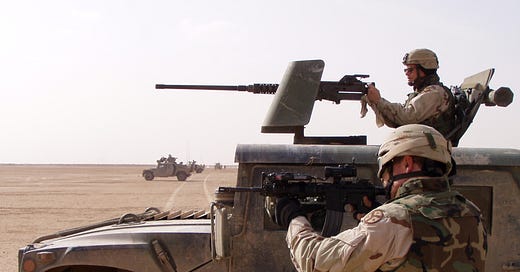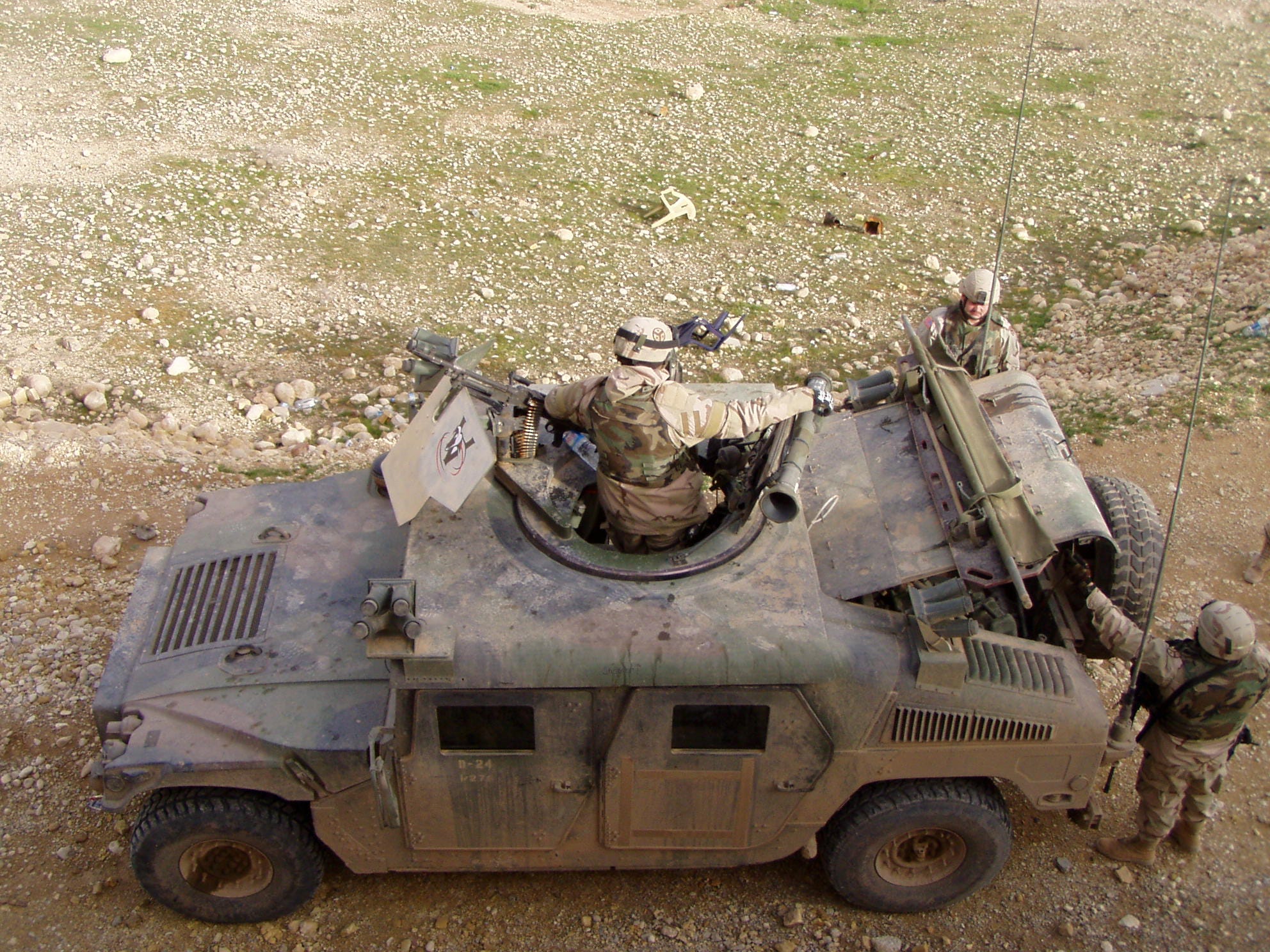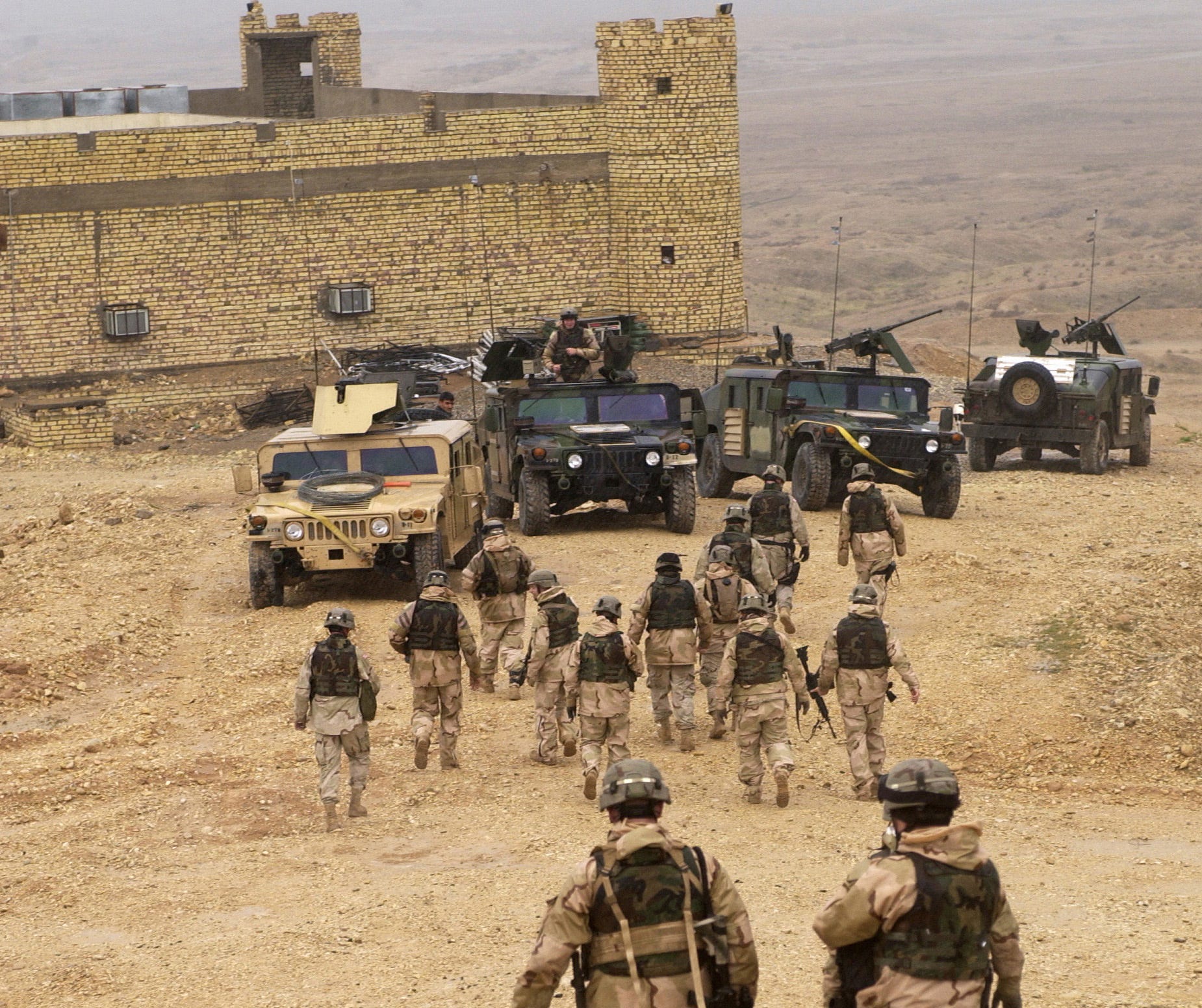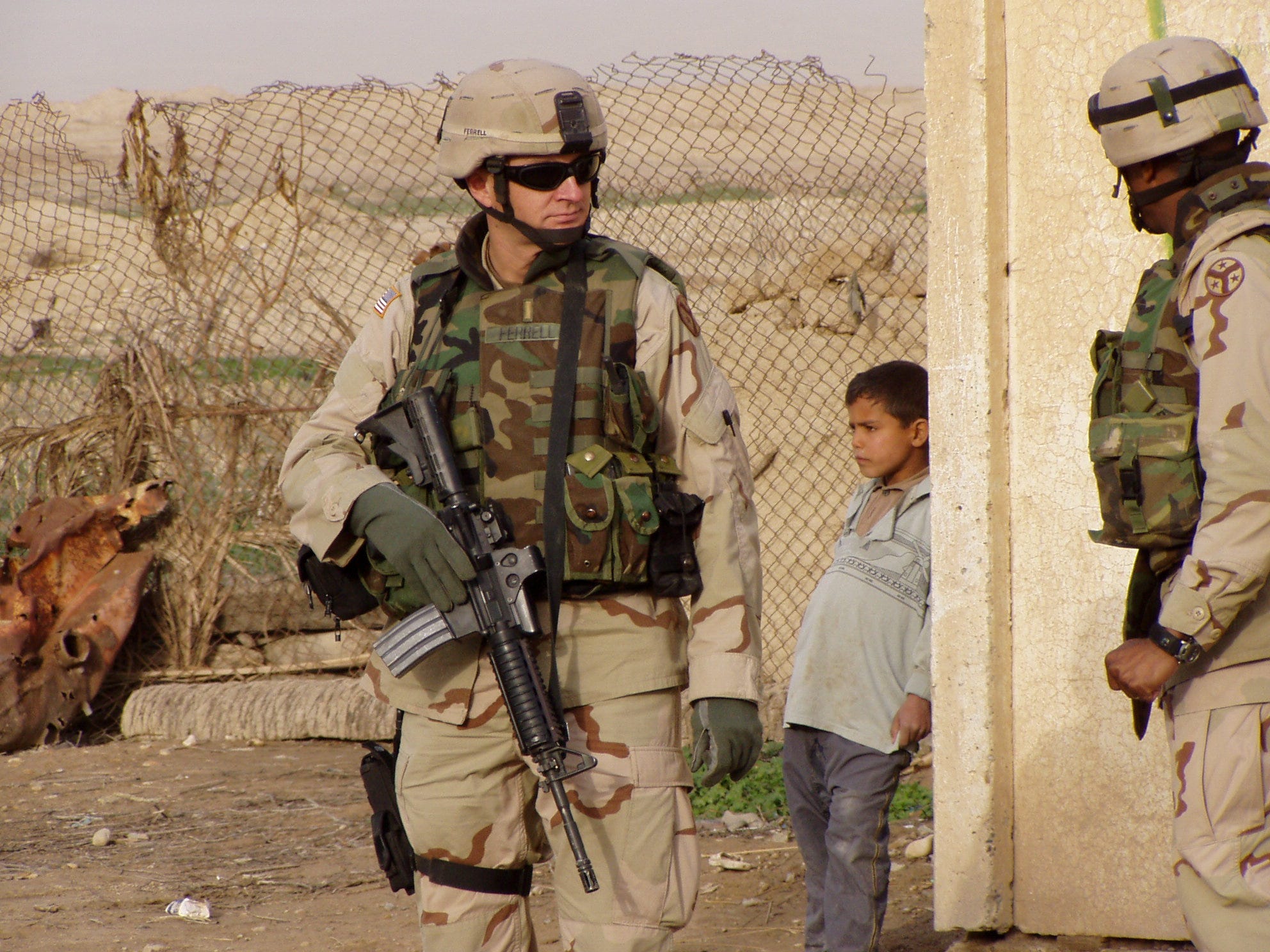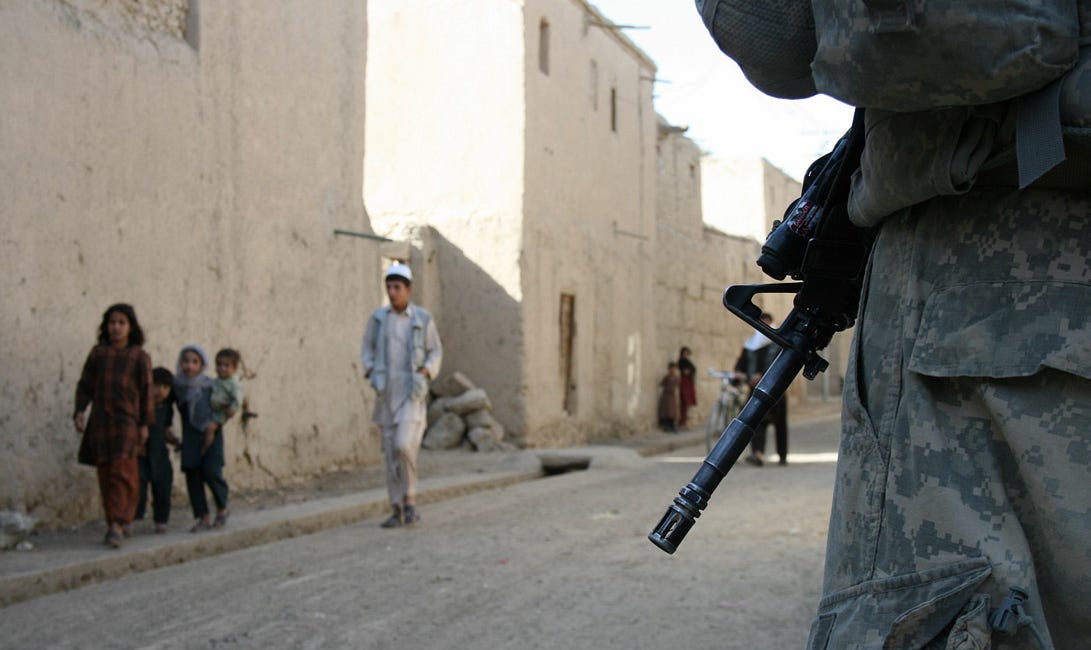Between February 2005 and March 2006, I traveled to Iraq several times for The Village Voice—the New York City alternative newspaper that folded in 2017 and now reappears only sporadically. I wrote 16 stories for The Village Voice. The paper paid me $1,000 for each, essentially launching my writing career.
My first story for The Village Voice appeared in February 2005, and captured the weird vibes among a bunch of Tennessee National Guardsmen squatting on the Iraq-Iran border. I’ve reprinted it below.
Flying east over Iraq from Saddam Hussein's birthplace Tikrit towards the Jabal Hamrin mountain range, which bisects the country like a shoulder sash draped southeast from Turkey, the landscape changes dramatically. Tikrit's flat, green riversides—and the towering palaces Hussein built there—give way to first squat, smoky villages where women in burkhas and little children in sweatshirts huddle behind earthen walls and packs of snarling dogs roam the muddy streets, then to geometric fields dotted with young men driving scrappy sheep. It's typical Sunni Iraq until the land begins to ripple and rise and shed its green, climbing and jutting into the Jabal Hamrin Mountains then dropping and smoothing out just as quickly into parched orange desert.
This is eastern Diyala Province, a sandbox the size of Connecticut boxed in by Kurds on the north, Shias on the south, minefields and Iranian soldiers on the east and mountains on the west.
In every direction, something is happening: the Sunni insurgency on the other side of the mountains claims a dozen lives every day while Shias in the south consolidate their hold on the new Iraqi government, autonomous Kurdistan plots and bides its time up north and Iran smugly flaunts its nuclear ambitions. But here, where barely half a million Iraqis—equal numbers of Sunnis, Shias and Kurds and a dash of Turkomens—eek out their livings making bricks, farming mud and bootlegging gasoline, it's quiet. This is the other Iraq, a place mostly unmolested by insurgents and terrorists, all but untouched by occupation and foreign aid and more or less at peace.
But the calm belies a subterranean rumbling. For this is a potential battleground between Iraq's religious and ethnic groups, and between the West and an ascendant nuclear-armed Iran. Here, more than anywhere else in Iraq, there is potential for war. Not just insurgency, mind you, and not just terrorism—but full-on, all-out 1,000 dead-per-day war, like the one between Iran and Iraq in the 1980s that turned this area into a dusty graveyard, killing or scaring off entire towns and littering the land with unidentifiable wreckage, cesspool craters and mines that inch through the earth.
Bootleggers, fobbits and a dog named Tripod
A chopper swoops down in a blast of dust and wind and settles on a gravel landing zone on the fringes of the U.S. Army's Forward Operating Base Caldwell near the town of Mandali, population 25,000 (120,000 before the Iran-Iraq War). Out hops a handful of soldiers and one scruffy reporter.
The base—or “fob,” as soldiers call it—is bustling. There are soldiers in Kevlar helmets and body armor carrying tricked-out rifles, walking to chow or gathering for briefings. There are rows of Humvees bristling with radio antennae and machine guns. There are helicopters, a few tanks, artillery pieces. And there's a small army of Halliburton contractors—Bangladeshis and Iraqis, mostly—who cook, clean and build everything. From Caldwell, just 3,500 soldiers of the Tennessee National Guard's 278th Armored Cavalry Regiment patrol the sandy wastes of eastern Diyala—fewer than one soldier per square mile.
Actually, only about half of the troops here patrol anything. They’re a grab bag of old-school National Guard types—white, male, middle-aged and Southern like Sgt. 1st Class William Rader, 44, of Tennessee—with some tough-as-nails active-duty soldiers like Californian 2nd Lt. Rick Ferrell, 33, thrown in to bring the unit up to full strength. The rest of the soldiers at Caldwell are what the combat types call “fobbits.” “If they take one step further off the fob, it’s the furthest they’ve ever gone,” Ferrell says. For fobbits, deployment is a lot like life in the States, only they wear uniforms and occasionally carry weapons—and the food, courtesy of Halliburton, is actually better.
But even for the combat types, duty in eastern Diyala is long on driving and short on actual combat. Just across the mountains, active-duty soldiers of the 1st Infantry Div. endure daily firefights and roadside bombings and die at a rate of a dozen per month. But here, bombings are rare and gunfights even rarer, and not a single 278th soldier has died. Some of the Tennessee Guardsmen estimate that, for them, being on deployment is actually safer than being at home. Statistically speaking, they're probably right.
That's not to say there's no action. On Feb. 6, 2005, soldiers from the 278th's Deacon Battery—Rader and Ferrell’s unit—arrest three men in the town of As Biliya after they lobbed three mortar rounds at a local government building where the battery keeps a contingent of soldiers and one three-legged guard dog named Tripod. Bombers have targeted the same building. Parked outside is a mangled Iraqi Police cruiser—evidence of a recent attack that wounded three local cops.
On Feb. 10, Deacon passes out pencils and candy in As Biliya to make amends for the arrests—“hearts and minds” stuff. The tension in the town is palpable, and the mother of two of the suspects hobbles out to curse at the soldiers.
On a Feb. 9 nighttime patrol, Deacon stops and searches several cars and trucks. One soldier holds an Iraqi trucker driver at gunpoint while another sniffs the metal drums he’s hauling. “Gasoline!” the soldier reports.
“The question is whether he’s bootlegging,” Ferrell says. “But how can you tell?”
The gasoline black market is a major source of income for many in Diyala, where a handful of brick factories passes as “industry”.
Ferrell lets the Iraqi go. “I don’t care about some guy trying to make a buck. I’m looking for anything dangerous.”
“Dangerous” means illegal weapons or bomb components. But Ferrell admits that his unit’s real mission isn’t catching insurgents, gun-runners or bootleggers—it’s keeping the Kurds and the Iranians from moving in on an unstable Iraq.
The Kurds are coming!
“Without us, the Kurds would have their own country by now,” Ferrell says, making him one of only a handful of Army officers to acknowledge the Kurds’ true aim: independence.
At two high-level briefings in January, officers at a base in Tikrit cite Iraqi Kurds’ desire for increased autonomy as one challenge facing the new Iraq. But the Kurds have been autonomous—with their own army, police, media and elected government—since the end of the 1991 Gulf War, when the U.S. began a decade of round-the-clock fighter jet patrols from Turkey aimed at keeping Saddam’s army out of northern Iraq, which became known (unofficially) as Kurdistan. So strong is Kurdistan’s autonomy that no American troops are allowed north of an unofficial line that bisects eastern Diyala—the Kurdish Green Line, which 278th spokesman Capt. Alan Mingledorf calls an “ethnic fault line.” North of the line, non-Kurds are viewed with suspicion. And even one American stepping over it would be akin to an invasion.
Rader puts it simply: “Kurds don’t like anybody else.”
And for good reason. Under Saddam, until after the Gulf War, Iraqi Kurds were oppressed, displaced, killed. Now, with the rest of Iraq in the hands of its former protector, Kurdistan is vying for true independence from Iraq—the first step towards a pan-Kurdistan that would include Kurdish-dominated regions of both Turkey and Iran. That, says Mingledorf, is not going to happen—at least not while the U.S. Army, which prefers a tolerant multi-ethnic Iraq, has any say in the matter.
But it’s already happening. In the 1980s, Saddam forced thousands of Kurds from their homes in Diyala and sent them north at gunpoint then resettled loyal Sunni Arabs in their places. Now the Kurds are coming back to reclaim their land – often by force. Nationally, the two major Kurdish political parties—the Patriotic Union of Kurdistan and the Democratic Party of Kurdistan—have backed a single slate of candidates for the new Iraqi National Assembly, in a move to win as much official power as possible for all Kurds. Meanwhile, local governments in eastern Diyala have begun stacking Iraqi Border Patrol units with Kurdish officers in order to control the flow of goods—both legal and illegal—across the border, and to levy fees on them, cash from which winds up in Kurdish coffers.
On a Feb. 10 visit to a Border Patrol castle overlooking the mine-strewn valley between Iraq and Iran—through which winds a road that’s older than the Bible—one Kurdish officer, Maj. Rashid Abid Kareem, says that there is no smuggling across the valley.
Ferrell grimaces, because he knows it’s a lie—and he knows that the Kurds have been collecting illegal taxes on illegal goods and exercising increasing control over a region they once claimed as their own, and may again some day soon.
And that’s not his only worry. Just minutes later, gazing across the minefields at an Iranian castle where Iranian officers are undoubtedly gazing right back, a rumble echoes off the valley walls. “Iranian artillery,” Ferrell says. “Just acknowledging our presence.”
Iran-Iraq, Round Two
Ferrell, Rader and the scruffy reporter are taking a break from their Feb. 9 nighttime patrol to gaze at the thousands of stars scattered like confetti on black velvet when silent explosions ignite the eastern horizon over Iran. Ferrell is pensive. “The Iranians like to do maneuvers to remind us that they’re out there.”
As if anyone could forget. In the heady days following Iraq’s first truly democrat elections, during which Diyala’s Kurds and Shias literally danced in the streets, the American press’ attention turned to Iran and its nuclear ambitions—as if to say, “We’re done with Iraq. Who’s next?”
But Ferrell laughs at the prospect of an American invasion of Iran for any reason—and Mingledorf cracks jokes about it. Especially hilarious is any talk of the 278th taking part in such an invasion. Normally equipped with hundreds of tanks and other armored vehicles and specializing in “breaching,” or breaking through enemy defenses, these days the 278th has traded in most of its big weapons for extra Humvees, which are more suitable for long—and relatively peaceful—patrols on desolate roads. “We couldn’t conduct a breach if we wanted to,” Mingledorf says.
The fact is that the 278th has its hands full in Iraq—and so does the rest of the U.S. Army. Islamic Iran has long been a painful thorn in secular Iraq’s strategic side—and now Iran’s smugglers and extremists sneak across the border, paying off Kurdish patrols, exporting their lawlessness and terrorism to a developing Iraqi market that has plenty of other problems, the Kurdish issue being just one.
Perhaps most terrifying is the prospect of an Iranian-style Shiite government in Iraq—one that is looking increasingly likely as elections results roll in. Such a government might welcome Iranian meddling, and might meet aggressive Kurdish moves with aggression of its own. In other words, civil war. If it happens, it will happen here, in eastern Diyala Province, the desolate desert that may shape Iraq’s future.
Read more:
Ambushed!
It started with a threat. At a checkpoint in Baraki Barak district in October 2009, Afghan security guards protecting the American combat outpost stopped a driver. When they insisted on searching the car, the driver rankled. “Fine,” he said, “you won’t be here in two days, anyways.”


